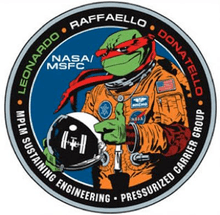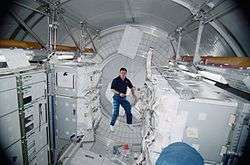Multi-Purpose Logistics Module

A Multi-Purpose Logistics Module (MPLM) was a large pressurized container used on Space Shuttle missions to transfer cargo to and from the International Space Station (ISS). A MPLM was carried in the cargo bay of a Shuttle and initially berthed to the Unity module but later the Harmony module on the ISS. From there, supplies were offloaded, and finished experiments and waste were reloaded. The MPLM was then reberthed in the Shuttle for return to Earth. Three modules were built by the Italian Space Agency (ASI), Leonardo, Raffaello and Donatello.[1]
The Leonardo module was modified in 2010 to turn it into the Permanent Multipurpose Module (PMM) and was permanently attached to the ISS during the STS-133 mission in March 2011. The Raffaello module in July 2011 was the last ever payload of a NASA Space Shuttle.
There were 37 Space Shuttle missions to the ISS. MPLMs were flown twelve times, with SPACEHAB modules flown nine times to ISS, and 25 Shuttle missions delivering construction elements, in various combinations.
Design
An MPLM is a large cylinder with a single berthing mechanism at one end.
Power during launch
In order to provide power to certain equipment and experiments inside the MPLM during launch, the MPLM could be electrically connected to the Shuttle's power supply by means of the Remotely Operated Electrical Umbilical (ROEU). The ROEU was mounted on the starboard side payload bay sidewall longeron, and was a folding arm umbilical that was connected to the MPLM while it was in the payload bay. The arm was disconnected and retracted prior to the MPLM being removed for placement on the ISS and then reconnected once the MPLM was placed back inside the payload bay.


History
The modules were provided to NASA under contract by the Italian Space Agency (ASI). Three MPLMs were built and delivered to NASA and have names chosen by the ASI to denote some of the great talents in Italian history: Leonardo da Vinci, Raffaello and Donatello. Although built by ASI, the modules are owned by NASA. In exchange for building the MPLMs, ASI receives access to U.S. research time on the ISS.[1]
The MPLMs have a heritage that goes back to Spacelab.[2] In addition, ESA's Columbus module, the Harmony and Tranquility ISS modules and the ATV and Cygnus resupply craft all trace their origins to the MPLMs.[2] The MPLM concept was originally created for Space Station Freedom. Initially, they were to be built by Boeing, but in 1992, the Italians announced that they would build a "Mini-Pressurized Logistics Module", able to carry 4,500 kilograms (4.5 t) of cargo. After the 1993 redesign of Freedom, the length was doubled and it was renamed the "Multi-Purpose Logistics Module". Each empty MPLM is approximately 21 feet (6.4 m) long, 15 feet (4.6 m) in diameter, weighs 4,400 kilograms (9,700 lb), and can deliver up to nine metric tons of cargo to the ISS.[1]
Donatello was a more capable module than its two siblings, as it was designed to carry payloads that required continuous power from construction through to installation on the ISS. However, Donatello was never used and some of its parts were cannibalized to convert Leonardo into the PMM.[3]
With the end of the Space Shuttle program in 2011, the Raffaello and Leonardo modules were flown a combined total of 12 times.
Program logo

Since the module names are also the names of three of the four Teenage Mutant Ninja Turtles, the NASA MPLM Group approached Mirage Studios (Teenage Mutant Ninja Turtles) artist A.C. Farley to design a logo with a ninja turtle in an astronaut flight suit.[4] There were cloisonné pins produced, as well as stickers and embroidered patches. There are supposed to be mission jackets using this design as well. Because the Ninja Turtles are copyrighted by Mirage Studios, NASA gave Mirage the copyright to the logo in exchange for the use of the studio's character on it.[4]
Missions

| Flight | Launch Date | Mission | Shuttle | MPLM | Mass Up (kg) |
Mass Down (kg) |
|---|---|---|---|---|---|---|
| 1 | 8 March 2001 | STS-102 ISS 5A.1 | Discovery | Leonardo | 10,213 | 6,540 |
| 2 | 19 April 2001 | STS-100 ISS 6A | Endeavour | Raffaello | 8,811 | 6,763 |
| 3 | 10 August 2001 | STS-105 ISS 7A.1 | Discovery | Leonardo | 9,467 | 7,799 |
| 4 | 5 December 2001 | STS-108 ISS UF-1 | Endeavour | Raffaello | 9,228 | 8,693 |
| 5 | 5 June 2002 | STS-111 ISS UF-2 | Endeavour | Leonardo | 10,753 | 9,140 |
| 6 | 26 July 2005 | STS-114 ISS LF 1 | Discovery | Raffaello | 8,301 | 9,110 |
| 7 | 4 July 2006 | STS-121 ISS ULF 1.1 | Discovery | Leonardo | 9,588 | 8,124 |
| 8 | 14 November 2008 | STS-126 ISS ULF 2 | Endeavour | Leonardo | 12,748 | 6,966 |
| 9 | 28 August 2009 | STS-128 ISS 17A | Discovery | Leonardo[5] | 12,601 | 8,927 |
| 10 | 5 April 2010 | STS-131 ISS 19A | Discovery | Leonardo | 12,371 | 9,242 |
| 11 | 24 February 2011 | STS-133 ISS ULF5 | Discovery | Leonardo PMM | N/A - part of ISS | |
| 12 | 8 July 2011 | STS-135 ISS ULF7[4] | Atlantis | Raffaello | 9,500 | 5,660 |
Specifications
The following are the specifications of the MPLM:[6]
- Length – 6.6 m (cylindrical part 4.8 m)
- Width – 4.57 m
- Mass – 4,082 kg empty; 13,154 kg fully loaded
- Habitable volume – 31 m3
Also equipped with the Common berthing mechanism
Future Use
Since the retirement of the ISS in 2024, the Donatello MPLM will be use on the HAB/MPLM configuration and the both Leonardo and Raffaello MPLM will be use on the MPLM/Node 1 configuration of the future Deep Space Habitat
Axiom Space plans to use a Multi-Purpose module for the Axiom Commercial Space Station.[7]
See Also
37KB a supply module used on the Buran Shuttle
References
- 1 2 3 "Multi-Purpose Logistics Modules". NASA. 2007.
- 1 2 "A new European science laboratory in Earth orbit" (PDF).
- ↑ http://www.spaceflightnow.com/shuttle/sts133/101007payloads/
- 1 2 3 "Multi-Purpose Logistics Module Office". NASA MSFC. Retrieved February 22, 2009.
- ↑ Chris Gebhardt (2008). "STS-128 – Atlantis' 2009 mission baselined by PRCB". NASAspaceflight.com.
- ↑ NASA. "What is MPLM?". Retrieved 11 June 2011.
- ↑ "Axiom Station". 24 July 2017.







.jpg)

.jpg)